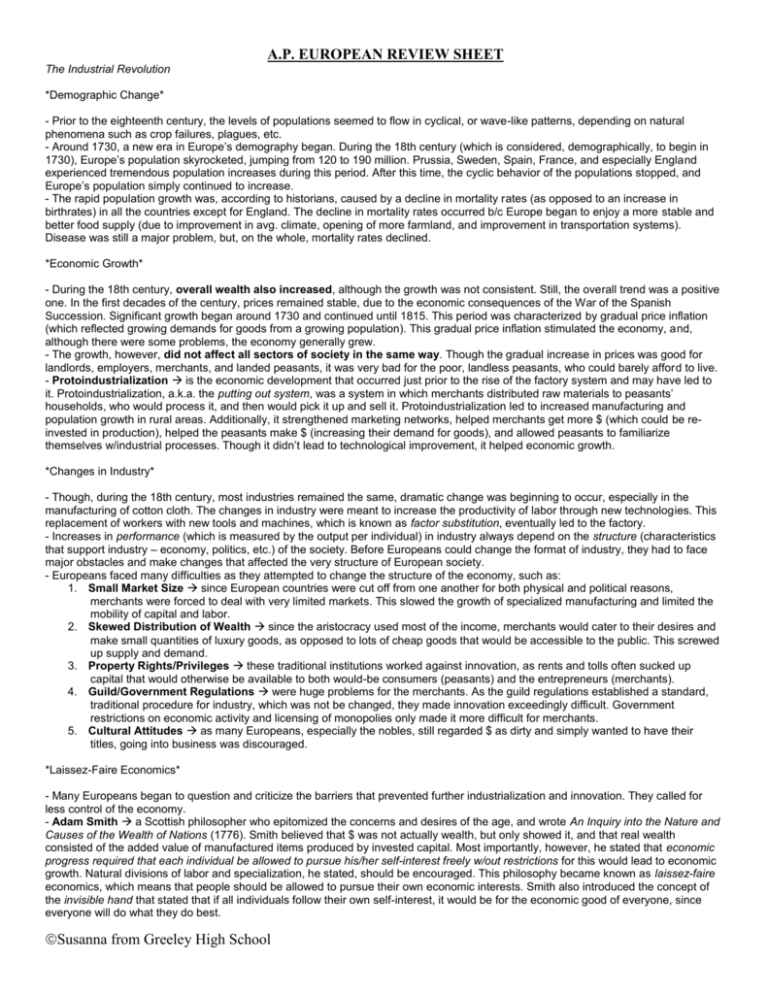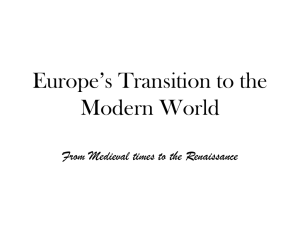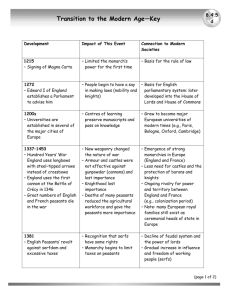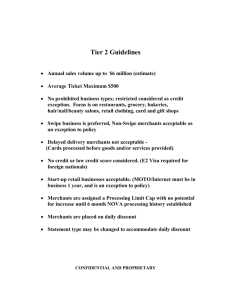Industrial Revolutions - Hinsdale South High School
advertisement

A.P. EUROPEAN REVIEW SHEET The Industrial Revolution *Demographic Change* - Prior to the eighteenth century, the levels of populations seemed to flow in cyclical, or wave-like patterns, depending on natural phenomena such as crop failures, plagues, etc. - Around 1730, a new era in Europe’s demography began. During the 18th century (which is considered, demographically, to begin in 1730), Europe’s population skyrocketed, jumping from 120 to 190 million. Prussia, Sweden, Spain, France, and especially England experienced tremendous population increases during this period. After this time, the cyclic behavior of the populations stopped, and Europe’s population simply continued to increase. - The rapid population growth was, according to historians, caused by a decline in mortality rates (as opposed to an increase in birthrates) in all the countries except for England. The decline in mortality rates occurred b/c Europe began to enjoy a more stable and better food supply (due to improvement in avg. climate, opening of more farmland, and improvement in transportation systems). Disease was still a major problem, but, on the whole, mortality rates declined. *Economic Growth* - During the 18th century, overall wealth also increased, although the growth was not consistent. Still, the overall trend was a positive one. In the first decades of the century, prices remained stable, due to the economic consequences of the War of the Spanish Succession. Significant growth began around 1730 and continued until 1815. This period was characterized by gradual price inflation (which reflected growing demands for goods from a growing population). This gradual price inflation stimulated the economy, and, although there were some problems, the economy generally grew. - The growth, however, did not affect all sectors of society in the same way. Though the gradual increase in prices was good for landlords, employers, merchants, and landed peasants, it was very bad for the poor, landless peasants, who could barely afford to live. - Protoindustrialization is the economic development that occurred just prior to the rise of the factory system and may have led to it. Protoindustrialization, a.k.a. the putting out system, was a system in which merchants distributed raw materials to peasants’ households, who would process it, and then would pick it up and sell it. Protoindustrialization led to increased manufacturing and population growth in rural areas. Additionally, it strengthened marketing networks, helped merchants get more $ (which could be reinvested in production), helped the peasants make $ (increasing their demand for goods), and allowed peasants to familiarize themselves w/industrial processes. Though it didn’t lead to technological improvement, it helped economic growth. *Changes in Industry* - Though, during the 18th century, most industries remained the same, dramatic change was beginning to occur, especially in the manufacturing of cotton cloth. The changes in industry were meant to increase the productivity of labor through new technologies. This replacement of workers with new tools and machines, which is known as factor substitution, eventually led to the factory. - Increases in performance (which is measured by the output per individual) in industry always depend on the structure (characteristics that support industry – economy, politics, etc.) of the society. Before Europeans could change the format of industry, they had to face major obstacles and make changes that affected the very structure of European society. - Europeans faced many difficulties as they attempted to change the structure of the economy, such as: 1. Small Market Size since European countries were cut off from one another for both physical and political reasons, merchants were forced to deal with very limited markets. This slowed the growth of specialized manufacturing and limited the mobility of capital and labor. 2. Skewed Distribution of Wealth since the aristocracy used most of the income, merchants would cater to their desires and make small quantities of luxury goods, as opposed to lots of cheap goods that would be accessible to the public. This screwed up supply and demand. 3. Property Rights/Privileges these traditional institutions worked against innovation, as rents and tolls often sucked up capital that would otherwise be available to both would-be consumers (peasants) and the entrepreneurs (merchants). 4. Guild/Government Regulations were huge problems for the merchants. As the guild regulations established a standard, traditional procedure for industry, which was not be changed, they made innovation exceedingly difficult. Government restrictions on economic activity and licensing of monopolies only made it more difficult for merchants. 5. Cultural Attitudes as many Europeans, especially the nobles, still regarded $ as dirty and simply wanted to have their titles, going into business was discouraged. *Laissez-Faire Economics* - Many Europeans began to question and criticize the barriers that prevented further industrialization and innovation. They called for less control of the economy. - Adam Smith a Scottish philosopher who epitomized the concerns and desires of the age, and wrote An Inquiry into the Nature and Causes of the Wealth of Nations (1776). Smith believed that $ was not actually wealth, but only showed it, and that real wealth consisted of the added value of manufactured items produced by invested capital. Most importantly, however, he stated that economic progress required that each individual be allowed to pursue his/her self-interest freely w/out restrictions for this would lead to economic growth. Natural divisions of labor and specialization, he stated, should be encouraged. This philosophy became known as laissez-faire economics, which means that people should be allowed to pursue their own economic interests. Smith also introduced the concept of the invisible hand that stated that if all individuals follow their own self-interest, it would be for the economic good of everyone, since everyone will do what they do best. Susanna from Greeley High School A.P. EUROPEAN REVIEW SHEET - Laissez-faire economics really caught on, especially in England, and in 1786 France and Britain signed a free-trade treaty. Guilds were growing weaker, and in 1791, the French got rid of them. In the 1790s, the English also began to pass laws against them, and the merchants gained freedom. *England Begins to Industrialize* - England was the first nation to develop a social structure supportive of innovation and economic growth. So, why was it England? This is b/c of many advantages, such as: 1. Geography England was close to the sea, which allowed trade w/foreign nations and colonies. Also, England had two great resources essential to industry, iron and coal, as well as a lot of good, productive farmlands. 2. Existing Capital to Invest the English began with a store of capital from the colonies, which led to the creation of a banking and investing system – the Bank of England – in 1694. The bank took responsibility of England’s public dept, sold shares to the public, and met the interest payments for shareholders. This helped stabilize the markets. 3. Free Trade the English had markets in their colonies, the other European powers (free trade agreement w/ France in 1786) and the Spanish colonies b/c of the Treaty of Utrecht. 4. Labor Supply slavery, cheap labor (peasants) due to the Enclosure Acts, which drove the peasants out of the communal farmlands and made them look for work. 5. Friendly Political Environment since the gentry were in control of the government (since they had Parliament) they could pass laws favorable to the merchants. 6. Navy need I say more? *Cotton Begins Industrialization* - Since England had developed a social structure supportive of industrialization, all it needed was a take off industry, or an industry that would begin a pattern of industrialization all the others would follow. In England’s case, this industry was cotton manufacturing. - Due to the slave labor in the plantations, there was a very large supply of raw cotton. There was also a very high demand for the durable, cheap cotton goods. However, the putting-out system had reached its limits in productions, so merchants were ready to take the next step towards industrialization. - Richard Arkwright inventor of the water frame, which was able to twist fibers into thread using waterpower. Before him, though weavers could make cloth quickly from yarn, production was slowed down b/c the yard couldn’t be made quickly enough. Arkwright shifted the balance the other way. Arkwright also made the very first factories. - James Watt inventor of the steam engine. Arkwright asked Watt to use steam engines to drive his spinning machines, and the first factories were created. - Edmund Cartwright inventor of a power-driven loom. Though the opposition of handloom weavers and technical flaws made the loom not really become available until the 19th century, once it became available, both spinning and weaving could go incredibly fast. - The cotton industry was revolutionized by the 19th century, for goods could be made incredibly fast, and merchants could house all their workers in factories and watch them work. After industrialization, the price of cotton fell tremendously, and it became available to many poorer people. *Changes in Agriculture* - In England, many peasants were able to leave the country and go to the city, where they found work as factory laborers, because of the new agricultural techniques, which caused an increase in efficiency and productivity. If it hadn’t been for these changes, the peasants could not have left. - Convertible Husbandry instead of letting land lie unused every second or third year (to prevent it from become infertile) agricultural innovators planted fields w/turnips (which could also provide feed for livestock, which could make fertilizer) to help it regain fertility. If they encountered other problems, they would experiment w/other crops that would hopefully fix the problems. - Charles Townshend innovator who proved the value of planting turnips instead of resting land. - Jethro Tull noble who was into agricultural innovation. - In addition to convertible husbandry, innovators experimented with selective breeding of animals. - Enclosure Movement throughout Europe, all towns shared communal lands, which were divided into small plots. This made it very difficult to change agricultural techniques, since the village as a whole had to agree to a certain technique. But, in England, Parliament was able to (in response to the petitioning of large landowners) enclose all the land in a village, even against the will of the village itself. Though enclosure was difficult and expensive, it was worth it, for it ended up generating high profits. In the end, the communal field system was practically eradicated in England, leading to the domination of rural society by great landlords and their tenant farmers. Enclosure also forced many peasants to leave for the cities, where they could then find work. - On the continent, however, things were very different, for, in Eastern Europe, nobles completely controlled the lives of their serfs, who spent their time in unpaid labor for their noble lord. In Western Europe, though there was no serfdom, most peasants lived under a system called seigneurialism, in which the peasants lived under a local lord and owed him certain obligations. Since, throughout the continent, peasants were barely surviving, they had little time to worry about efficiency (change was too risky to afford). So change came very slowly, especially in Eastern Europe. *Eighteenth-Century Colonial Empires* - After 1715, the three original imperial powers began to decline. Portugal retired from active competition (but kept Brazil), the Dutch could only hope to protect their existing lands, and the Spanish grew weaker, thought they still tried to keep their monopoly over trade. Susanna from Greeley High School A.P. EUROPEAN REVIEW SHEET - So, the English and the French became the new colonial powers. The British and the French expanded their control in the West Indies, West Africa, North America, and India/Asia (where they established trading empires). Though the English and the French had different administrative techniques for their colonies (English didn’t directly control the colonies as much as the French did) both countries relied on mercantilist techniques. So, the powers attempted to keep a trading monopoly with their colonies. They did so using their naval powers. - Colonial trade provided new products, stimulated the economy and trade (remember Triangular Trade), and was based on slavery, which decimated Africa. - The intense competition between the French and English soon led to fights throughout their empires. Fighting broke out in Canada/North America, the Ohio Valley (since the French began establishing strongholds in the wilderness, the British feared that westward expansion would be cut off). The French gained the allegiance of the American Indians (as they were not settlers, the Indians felt that their presence would be better for them than the English). - The Great War for Empire after years of hostilities, an official war broke out in 1756. This war, which was known as the Seven Years’ War in Europe, was known as the French and Indian war in North America and the Great War for Empire throughout. As the British (led by William Pitt) had control of the seas, they were able to cut off supplies from France and win the war in 1759. - The Treaty of Paris ended the war and was favorable for England, though, in exchange for peace, the English gave back some of the French islands they had taken. But the English got Canada. - The British in India the British entered India and gained control gradually, first through the British East India Company and later on directly through the English government itself (after Sepoy mutiny). The British made a class loyal to them by turning the landlords into a class of nobility and giving them control over their lands. The British also educated an Indian bureaucracy trained in their ways. Many people were drawn to India, mainly to make $, but some to “help civilize” the country. - On the whole, the colonies greatly stimulated the economy, and also led to increased competition. However, not all groups were helped by the growth of the eighteenth century, for the peasants and slaves, who were t Susanna from Greeley High School







